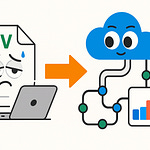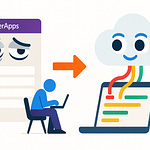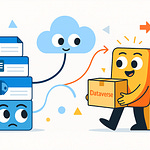Admins, remember when Power BI Premium felt like your biggest headache? Overnight, you’re suddenly a Fabric Administrator, staring at domains, capacities, and tenant configs like a set of IKEA instructions written in Klingon. Microsoft says this makes things “simpler.” Our experience shows it just means fifty new moving parts you didn’t ask for.
By the end, you’ll know what to lock down first, how to design workspaces that actually scale, and how to avoid surprise bills when capacity goes sideways. Subscribe to the M365.Show newsletter so you get our Fabric survival checklist before chaos hits.
Let’s start with domains. Microsoft says they “simplify organization.” Reality: prepare for sprawl with fancier nametags.
Domains Aren’t Just New Labels
Domains aren’t just another batch of Microsoft labels to memorize. They change how data, people, and governance collide in your tenant—and if you treat them like renamed workspaces, you’ll spend more time firefighting than managing.
On the surface, a domain looks tidy. It’s marketed as a logical container: HR gets one, Finance gets one, Marketing gets one. Sounds neat until you realize each domain doesn’t just sit there quietly—it comes with its own ownership, policies, and permission quirks. One team sees it as their sandbox, another sees it as their data vault, and suddenly you’re refereeing a brawl between groups who have never once agreed on governance rules.
The scope is bigger too. Workspaces used to be about reports and maybe a dataset or two. Now your Marketing domain doesn’t just hold dashboards—it’s sucking in staging pipelines, raw data ingests, models, and random file dumps. That means your business analyst who just wanted to publish a campaign dashboard ends up sharing space with a data engineer pushing terabytes of logs. Guess who dominates that territory? Not the analyst.
Then comes the permission puzzle. You’re not just picking Viewer, Contributor, or Admin anymore. Domains bring another layer: domain-level roles and domain-level policies that can override workspace rules. That’s when you start hearing from users: “Why can’t I publish in my own workspace?” The answer is buried in domain settings you probably didn’t know existed when you set it up. And every one of those support pings ends up at your desk.
Here’s the metaphor that sticks: setting up domains without governance is like trying to organize your garage into “zones.” You put tools on one wall, bikes in another corner, boxes on shelves. Feels under control—until the neighbors dump their junk in there too. Now you’re tripping over someone else’s lawnmower trying to find your screwdriver. That’s domains: the illusion of neat order without actual rules. The punchline? Domains are an opportunity for chaos or control—and the only way you get control is by locking a few things in early.
So what do you lock? First 30 days: define your domain taxonomy. Decide whether domains represent departments, projects, or purposes. Don’t let people invent that on the fly. First 60 days: assign single ownership with a clear escalation path. One team owns structure, another enforces usage, and everybody else knows where to escalate. First 90 days: enforce naming rules, then pilot policies with one team before rolling them out everywhere. That gives you a safe zone to see how conflicts actually surface before they become tenant-wide tickets.
And what do you watch for along the way? Easy tells that a domain is already misconfigured: multiple near-identical domains like “Sales,” “Sales Reporting,” and “Sales 2025.” Owners you’ve never heard of suddenly holding keys to sensitive data. Users reporting mysterious “can’t publish” errors that resolve only when you dig into domain policies. Each of these is a canary in the coal mine—and if you ignore them, the sprawl hardens fast.
We’ve seen domain sprawl happen quickly when teams can create domains freely. It’s not hypothetical—it only takes one unchecked department creating a new shiny container for their project, and suddenly you’ve got duplicates and silos sprouting up. The mess builds quicker than you think, and unlike workspaces, a domain is bigger by design, which means the fallout stretches further.
The fix isn’t abandoning domains. Done right, they actually help carve order into Fabric. But doing it right means starting boring and staying boring. Naming conventions aren’t glamorous, and ownership charts don’t impress in a slide deck. But it’s exactly that unsexy work that prevents months of renaming, re-permissioning, and explaining to your boss why Finance can see HR’s data warehouse.
Domains don’t magically simplify anything. You’ve got to build the scaffolding before they scale. When you skip that, Microsoft’s “simpler organization” just becomes another layer of chaos dressed up in clean UI. And once domains are running wild, the next layer you’ll trip over isn’t naming—it’s the foundation everything sits on: workspace architecture. That’s where the problems shift from labels to structure, and things start looking less like Legos and more like a Jenga tower.
Workspace Architecture: From Lego to Jenga
Now let’s dig into workspace architecture, because this is where admins either set order early or watch the entire tenant bend under its own weight. Old Power BI workspaces were simple—few reports, a dataset, done. In Fabric, that world is gone. Workspaces are crammed with lakehouses, warehouses, notebooks, pipelines, and the dashboards nobody ever stopped building. Different teams—engineering, analysts, researchers—are all piling their work into the same bucket, and you’re supposed to govern it like it’s still just reporting. That mismatch is where the headaches start.
The scope has blown up. Workspaces aren’t just about “who sees which report” anymore. They cover ingestion, staging, analysis, and even experimentation. In the same space you’ve got someone dumping raw logs, another team tuning a model, and another trying to prep board slides. Mixing those roles with no structure means unstable results. Data gets pulled from the wrong copy, pipelines overwrite each other, performance sinks, and you’re dealing with another round of help desk chaos.
The trap for admins is assuming old rules stretch to this new reality. Viewer and Member aren’t enough when the question is: who manages staging, who protects production, and who keeps experiments from knocking over production datasets? Workspace roles multiply risk, and if you manage them like it’s still just reports, you’re courting failure.
Here’s what usually happens. Someone spins up a workspace for a “simple dashboard.” Six months later, it’s bloated with CSV dumps, multiple warehouses mislabeled, a couple of experimental notebooks, and datasets pointing at conflicting sources. Analysts can’t tell staging from production, someone presents the wrong numbers to leadership, and the blame lands on you for letting it spin out of control.
Microsoft’s advice is “purpose-driven workspaces.” Good guidance—but many orgs treat them like folders with shinier icons. Need Q4 content? New workspace. Need a sandbox? New workspace. Before long, you’ve got dozens of abandoned ones idling with random objects, still eating capacity, and no clear rules holding any of it together.
So how do you cut through the chaos? Three rules—short and blunt. Separate by function. Enforce naming and lifecycle. Automate with templates. That’s the backbone of sustainable Fabric workspace design.
Separate by function: Staging, production, and analytics don’t belong in the same bucket. Keep them distinct. One workable pattern: create a staging workspace managed by engineering, a production workspace owned by BI, and a shared research space for experiments. Each team knows their ground, and reports don’t pull from half-built pipelines.
Enforce naming and lifecycle: Don’t trust memory or guesswork. Is it SALES_PROD or SALES_STAGE? Tagging and naming stop the mix-ups. Pair it with lifecycle—every space needs an owner and expiry checks, so years from now you aren’t cleaning up junk nobody remembers making.
Automate with templates: Humans forget rules; automation won’t. Build a workspace template that locks in owners, tags, and naming from the start. Don’t try to boil the ocean—pilot with one team, smooth the wrinkles, then expand it.
Admins always want a sanity check: how do you know if you’ve structured it right? Run three quick tests. Are production reports separated from experiments? Can an experimenter accidentally overwrite a production dataset? Do warehouses and pipelines follow a naming convention that a stranger could recognize in seconds? If any answer is “no,” your governance won’t scale.
The payoff is practical. When staging blows up, it doesn’t spill into production. When executives need reporting, they aren’t pulling test data. And when workloads start climbing, you know exactly which spaces should map to dedicated capacity instead of scrambling to unpick the mess later. Architecture isn’t about controlling creativity, it’s about making performance and governance predictable.
Done right, architecture sets you up to handle the next big challenge. Because once multiple workspaces start hammering workloads, your biggest strain won’t just be who owns what—it’s what’s chewing through your compute. And that’s where every admin who thinks Premium still means what it used to gets a rude surprise.
Capacities: When Premium Isn’t Premium Anymore
Capacities in Fabric will test you in a way Premium never did. What used to feel like a horsepower upgrade for reports is now a shared fuel tank that everything taps into—reports, warehouses, pipelines, notebooks, and whatever else your teams spin up. And once everyone starts running at the same time, the rules you thought you knew collapse fast.
Here’s the blunt truth: your old Premium setup does not map directly to Fabric. Don’t assume your reporting SKUs translate neatly into compute resources here. Measure, don’t assume. Because suddenly it’s not just about snappy dashboards—your neatly tuned report is competing against an engineer running a giant pipeline job or a scientist who left a warehouse humming in the background all week. That’s not a fair fight.
I’ve seen organizations migrate under the assumption they could lift and shift old Premium footprints unchanged. Within days, complaints hit: reports stalling, scheduled refreshes delayed, and users thinking the “upgrade” was actually a slowdown. It wasn’t the reports themselves—they hadn’t ballooned in size—it was the new competing workloads chewing cycles from the same capacity pool without anyone realizing it.
Think of it like this. Old Premium was dessert delivery—pay more and the cake shows up fast. Fabric is the buffet table where every course goes on the same tray. Warehouses, pipelines, notebooks, dashboards—everyone piles on. If you want dessert later, you’d better hope the buffet isn’t already cleared out. Capacity doesn’t care who you are, it just gets eaten until it’s gone.
So how do you keep that buffet from collapsing? Three steps: Identify critical workloads first—those dashboards executives expect instant access to every morning. Put them on dedicated capacity if possible, so they don’t drown when experimental projects crank up compute. Then steer experimental and “learning” workloads to shared or budget-limited pools. That’s how you stop your CEO’s dashboard from waiting in line behind twenty test notebooks.
That’s strategy, but you still need immediate action. As soon as you migrate, run a triage audit. Capture at least a week of peak-hour usage. Make sure you’re logging which workloads consume the most compute. Then set alerts for sudden drains on capacity so you don’t find out through trouble tickets. Once you’ve mapped the top consumers, walk the results to finance—yes, finance—because budgeting has to change.
Here’s the line you can use in that meeting: “Think of capacity as a shared compute budget. Critical business reports need their own dedicated slots, otherwise everyone else’s work eats their lunch.” That’s plain language leadership understands. It frames the cost not as another license tax but as protecting the data your business actually runs on.
Monitoring matters too. The old Power BI workspace usage views won’t tell you the story anymore. Use Fabric-provided monitoring and metrics views—they’ll at least show you what categories of workloads are burning cycles. It’s not perfect, but it gives you the ammunition to separate culprits from victims when people start pointing fingers.
Bottom line: stop thinking Premium history gives you a head start. This is a different economy. Reports, warehouses, and pipelines all behave differently, and they all spike differently. Treat capacity not as a switch you’ve paid for but as a budget that multiple stakeholders spend from—some responsibly, some recklessly.
And just when you feel like you’ve tamed that shared budget, you realize capacity isn’t the only thing that can blow a hole in your governance model. There’s another layer waiting—settings buried at the tenant level that look harmless but can undo all the guardrails you built if defaults stay untouched. That’s where we head next.
Tenant Configs: The Silent Breakers
Tenant configs are where the real accidents happen. Microsoft frames them as “just a few new settings,” but one careless toggle can undo years of governance in a single afternoon. It’s less like managing policy and more like living with a breaker box that isn’t labeled—and when you hit the wrong switch, you don’t just lose a lightbulb, you take out the entire kitchen.
Back in the Power BI days, tenant settings were limited and predictable. You had a handful of controls on sharing, exporting, and labeling. It wasn’t perfect, but at least you knew the edges. Fabric changes that by dragging in whole new surfaces—warehouses, lakehouses, notebooks, pipelines—and each of them comes with tenant-level controls you probably haven’t reviewed yet. The danger isn’t obvious failure; the danger is that these defaults don’t match the guardrails you thought were already in place.
Here’s the catch: don’t assume your old Power BI defaults carry forward. They don’t. When Fabric lights up new features, Microsoft often sets them with “helpful” defaults that lean heavily toward self-service. That means end users may suddenly have the power to build objects you never scoped, move data outside your compliance model, or rack up compute charges no one budgeted for. From the user’s perspective, it works. From your perspective, it’s a time bomb.
So how do you keep from stepping on those silent breakers? First task: run a tenant settings audit. And I mean step by step. Export your current tenant settings. Document which toggles are Fabric-specific. Compare them against your existing governance baseline. Then flag the ones that allow uncontrolled self-service—things like users freely creating their own warehouses, lakehouses, or notebooks. This is the boring work that saves you from explaining to leadership why half the finance department stood up duplicate data stores without tagging them.
Once you’ve mapped the hazards, you move to action. Disable self-service features where the risk outweighs the value. Require approval before new warehouses or lakehouses spin up. And for every new object type Fabric introduces, tie it into your sensitivity labeling policies at creation. Don’t treat this as optional. If you let people create without labels, you guarantee you’ll spend months chasing data already out in the wild.
One survival tip: never reconfigure these toggles blindly across the tenant. Pilot them. Use a subset of users, or even a test tenant if you have one, to check impact. And log every change you make so you can roll it back if something breaks. It’s basic risk management, but it will save your weekends when someone’s “quick toggle change” cuts off a whole department’s access.
Also, don’t try to memorize all this from a podcast. For the exact toggle names and their current behavior, check Microsoft’s documentation or confirm with your account rep. They’re the only ones who can give you the definitive list, since Fabric is still evolving and defaults have been known to shift between rollouts. What I’m giving you here are the principles: audit, lock down risky toggles, enforce labels, test changes, and keep a rollback.
Think of tenant configs as the skeleton holding Fabric upright. If you don’t check the bones, the whole thing can wobble no matter how good your workspace or domain design is. And the problem isn’t going away—because every new Fabric feature adds one more lever in that breaker box. If you’re not auditing them regularly, governance will slip quietly before you ever see smoke.
Bottom line: inherited trust from Power BI doesn’t cover Fabric. Defaults are not your ally. Tenant settings need deliberate oversight, or they’ll happily unravel years of security policy without you noticing until the auditors show up. Run the audit, align the toggles back to your governance baseline, and keep that cycle alive as new features hit.
And here’s the bigger picture. If tenant configs already stretch your governance playbook, you can imagine what happens when you try to manage all these services together under Microsoft’s “unified” branding. The label says one thing, but the reality feels very different.
Unified Analytics or Unified Headaches?
Unified analytics sounds like a dream until you’re the one running it. Microsoft positions Fabric as that clean, unified surface where everything lines up under one roof. But when you wear the admin badge, it doesn’t feel unified at all—it feels like juggling five separate products while pretending they’re one.
On the marketing slide, Fabric looks simple. OneLake in the middle, then warehouses, lakehouses, pipelines, notebooks, and Power BI orbiting around it like tidy planets. In practice, each of those planets comes with its own rules, gravity, and orbit speed. You’re the one trying to keep them aligned while Microsoft insists it’s all one neat universe.
They call it a “single admin surface.” The reality? You’re still stitching metrics, settings, and logs across services yourself. OneLake demands storage policies. Warehouses need capacity management. Pipelines need scheduling and retry rules. Power BI still depends on workspace and dataset discipline. That’s four operational headaches before you even look at notebooks or dataflows. Unified? Maybe in branding—certainly not in your day-to-day tasks.
Here’s a real scar from my own tenant. We had a clean Power BI model—sensitivity labels, role-based policies, dev and prod neatly separated. Felt solid. Then Fabric rolled in. Within a week, a data scientist dropped CSVs in a lakehouse, slapped together a notebook, and blazed past the very rules we’d enforced in BI. Leadership noticed because they saw numbers in an email screenshot that didn’t match official dashboards. It wasn’t sabotage. It was simply Fabric’s services operating under different guardrails. And it put us on the back foot instantly. The fix? We had to extend the same security baseline—labels, ownership, separation—into every new Fabric surface, not just dashboards.
This is why admins feel like Fabric piles the job higher. You sign up to manage reporting, and suddenly you’re dealing with storage access, pipeline behavior, and runtime governance for notebook workloads. The role creep is real. Admins who came from BI are now knee-deep in data engineering governance, whether they asked for it or not.
Think about it like a Swiss Army knife missing instructions. Yes, it’s one tool. But every blade opens differently, some are dull, and every other one cuts your fingers when you grab it wrong. That’s “unified analytics.” The pieces live in the same handle, but it’s you who has to figure out how to carry, sharpen, and not get sliced.
How do you survive it? You don’t wait for Microsoft to hand you a true single pane. Instead, you build administrative unification yourself. Start with shared governance principles that apply to every surface: clear naming rules, dev/prod separation, and ownership accountability. Deploy workspace and domain templates so teams don’t improvise structure. Centralize your logs—whatever Fabric gives you, plus anything you can export—into a single reporting store, even if it means pushing them into a warehouse or SIEM. And most importantly, write a simple runbook for cross-surface incidents: if a pipeline eats capacity and breaks reports, who gets paged and where do you look first?
That’s your “admin pane of glass”—not a product feature, but a pattern you put in place. And before you ask, yes, monitoring support varies. Some tenants have access to consolidated APIs, some need extra tooling. Always verify your own environment and lean on your architecture docs or partners to see what’s exposed. Don’t assume the overview dashboard will tell the full story—it won’t.
The mantra I teach my team is simple: unified billing does not equal unified governance. Say it out loud, because that line will save you disappointment. Fabric puts every cost under one line item, but the governance work is still yours to design and enforce.
If you take nothing else away, remember this: Fabric won’t shrink your workload. What it does is stack complexity in new shapes under a single logo. The only way through it is to treat governance like a system you own end to end. That’s what keeps it consistent when marketing promises don’t line up with reality.
And once you truly accept that, you stop waiting for Fabric to “get simpler.” You start treating it as complicated by nature—and you prepare to manage noise instead of chasing the dream of easy mode. That perspective is what sets you up to stay ahead the next time Microsoft rebrands the same toolbox and calls it something new.
Conclusion
So what’s the takeaway? Fabric won’t get simpler, but you can make it survivable if you act with discipline instead of hope. Three moves keep you sane: First: Audit tenant defaults and lock down risky self-service. Secound: Design a workspace taxonomy and enforce it with templates. Last: Map capacity to business‑critical workloads and set alerts before finance calls about the bill.
If you only have 15 minutes today, do one thing: check a single tenant toggle or run a naming audit on one domain.
Subscribe at m365.show for the Fabric survival checklist and live MVP sessions. Stay sharp.











